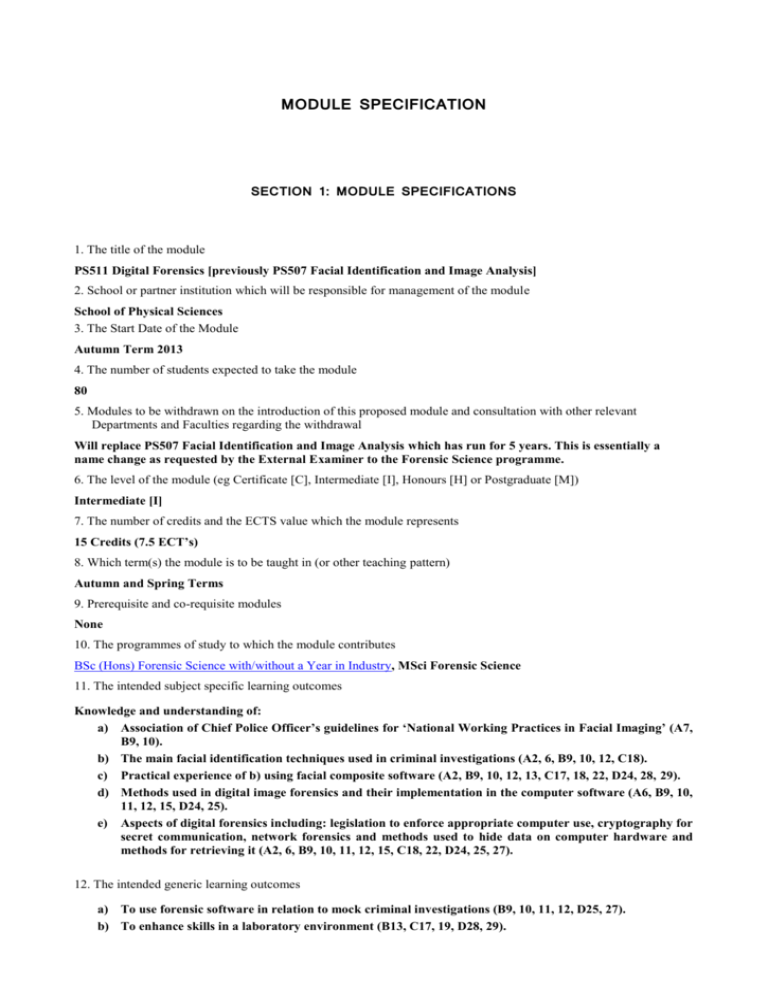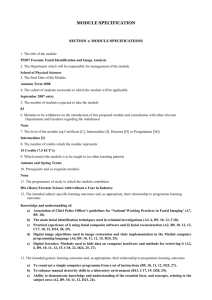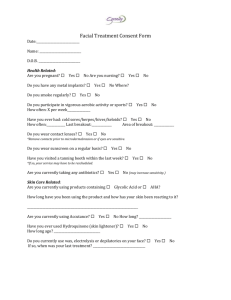
MODULE SPECIFICATION
SECTION 1: MODULE SPECIFICATIONS
1. The title of the module
PS511 Digital Forensics [previously PS507 Facial Identification and Image Analysis]
2. School or partner institution which will be responsible for management of the module
School of Physical Sciences
3. The Start Date of the Module
Autumn Term 2013
4. The number of students expected to take the module
80
5. Modules to be withdrawn on the introduction of this proposed module and consultation with other relevant
Departments and Faculties regarding the withdrawal
Will replace PS507 Facial Identification and Image Analysis which has run for 5 years. This is essentially a
name change as requested by the External Examiner to the Forensic Science programme.
6. The level of the module (eg Certificate [C], Intermediate [I], Honours [H] or Postgraduate [M])
Intermediate [I]
7. The number of credits and the ECTS value which the module represents
15 Credits (7.5 ECT’s)
8. Which term(s) the module is to be taught in (or other teaching pattern)
Autumn and Spring Terms
9. Prerequisite and co-requisite modules
None
10. The programmes of study to which the module contributes
BSc (Hons) Forensic Science with/without a Year in Industry, MSci Forensic Science
11. The intended subject specific learning outcomes
Knowledge and understanding of:
a) Association of Chief Police Officer’s guidelines for ‘National Working Practices in Facial Imaging’ (A7,
B9, 10).
b) The main facial identification techniques used in criminal investigations (A2, 6, B9, 10, 12, C18).
c) Practical experience of b) using facial composite software (A2, B9, 10, 12, 13, C17, 18, 22, D24, 28, 29).
d) Methods used in digital image forensics and their implementation in the computer software (A6, B9, 10,
11, 12, 15, D24, 25).
e) Aspects of digital forensics including: legislation to enforce appropriate computer use, cryptography for
secret communication, network forensics and methods used to hide data on computer hardware and
methods for retrieving it (A2, 6, B9, 10, 11, 12, 15, C18, 22, D24, 25, 27).
12. The intended generic learning outcomes
a) To use forensic software in relation to mock criminal investigations (B9, 10, 11, 12, D25, 27).
b) To enhance skills in a laboratory environment (B13, C17, 19, D28, 29).
c)
Ability to demonstrate knowledge and understanding of the essential facts, and concepts, relating to the
subject area (A2, B9, 10, 11, 12, D23, 24).
13. A synopsis of the curriculum
Facial Identification [3 lectures + 6 laboratory]
Facial reconstruction, facial composites, description by witness – cognitive interview - Turnbull’s rules (R v
Turnbull, 1976), identity parades – psychology of facial identification – video identity parades, facial mapping,
automated recognition technologies, age progression.
Digital Image Analysis [9 lectures + 2 laboratory]
Image formation, image storage, image distortion, image restoration methods, the digital image in crime
detection, steganography (implementation and detection).
Digital Forensics [ 8 lectures + 2 laboratory]
Encryption, fallacies about hiding and destroying data, where to find data and methods for retrieving it, disk
imaging, file integrity, cryptographic hashing, privacy vs need for investigation.
14. Indicative Reading List
Crime Scene to Court, The Essentials of Forensic Science, 2 nd edition, ed. P. White. Royal Society of Chemistry,
2004. ISBN: 0854046569.
Digital Image Processing using Matlab, Gonzalez, Woods and Eddins, Pearson Prentice Hall, 2004.
Handbook of Computer Crime Investigation, E. Casey, Academic Press, 2002.
15. Learning and Teaching Methods, including the nature and number of contact hours and the total study hours which
will be expected of students, and how these relate to achievement of the intended module learning outcomes
Contact hours comprising: 20 Lectures (learning outcomes: 11a, 12c), 10 two hour Laboratory Classes
(Learning outcomes: 11b, c, d, e 12a, b). Private study (110 hours) including time to complete assignments
16. Assessment methods and how these relate to testing achievement of the intended module learning outcomes
Assessment is by examination (60%) and continual assessment (40%). The subject specific learning outcomes
(a-e) and generic learning outcome (c) will be determined by examination and by assignments as appropriate.
Generic learning outcome (b) will be monitored by laboratory demonstrators/supervisors. Generic learning
outcome (a) will be monitored in computer console sessions and assessed by continuous assessment assignments.
17. Implications for learning resources, including staff, library, IT and space
The module has already been delivered (as PS507) and no additional resources are required.
18. The School/Collaborative Partner (delete as applicable) recognises and has embedded the expectations of current
disability equality legislation, and supports students with a declared disability or special educational need in its
teaching. Within this module we will make reasonable adjustments wherever necessary, including additional or
substitute materials, teaching modes or assessment methods for students who have declared and discussed their
learning support needs. Arrangements for students with declared disabilities will be made on an individual basis, in
consultation with the University’s/Collaborative Partner’s (delete as applicable) disability/dyslexia support service,
and specialist support will be provided where needed.
All teaching provision will conform with the University of Kent equal opportunities statements, with no
disadvantage anticipated.
19. Campus(es) where module will be delivered
Canterbury
If the module is part of a programme in an Associate College, please complete the following:
N/A
SECTION 2: MODULE IS PART OF A PROGRAMME OF STUDY IN A UNIVERSITY SCHOOL
Statement by the School Director of Learning and Teaching: "I confirm I have been consulted
on the above module proposal and have given advice on the correct procedures and required
content of module proposals"
................................................................
..............................................
Director of Learning and Teaching
Date
…………………………………………………
Print Name
Statement by the Head of School: "I confirm that the Department has approved the introduction
of the module and, where the module is proposed by Departmental staff, will be responsible for
its resourcing"
.................................................................
..............................................
Head of School
Date
…………………………………………………….
Print Name










